Fly The First Of The USAF’s Legendary
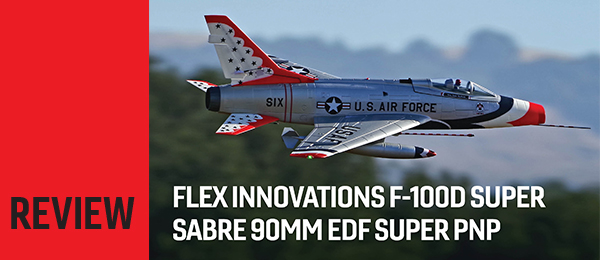
Written by Jon Barnes
Flex Innovations F-100D Super Sabre 90mm EDF Super PNP
As seen in the January 2021 issue of Model Aviation.
Review
Bonus Video
At a Glance

Specifications
Model type: Foam EDF jet
Skill level: Intermediate
Wingspan: 45.7 inches
Wing area: 622 square inches
Length: 55.5 inches
Weight: 7.5 pounds
Power system: 90 mm EDF
Radio: Minimum seven channels required
Construction: EPO foam
Price: $529.99
Test-Model Details
EDF: 11 blade, 90 mm
Motor: Potenza 60BLDF 1,600 Kv brushless outrunner
ESC: 100-amp V-Good with internal 8-amp BEC
Battery: Six-cell 22.2-volt 4,200 to 6,200 mAh recommended; flown on six-cell 22.2-volt 5,000 to 5,500 mAh
Flight controller: Aura 8 AFCS three-axis gyro system
Radio system: Spektrum DX9 transmitter; Spektrum AR8010T receiver
Ready-to-fly weight (with 6S 5,000 mAh pack): 7 pounds, 5 ounces
Flight duration: 2.5 to 4 minutes

Pluses
- Available in either a SEA camouflage scheme or a silver USAF Thunderbirds scheme.
- 90 mm EDF power system includes an exhaust tube with no auxiliary air intakes that could potentially detract from the model’s overall scalelike appearance.
- Included Aura 8 advanced flight controller/three-axis gyro stabilization system is tuned and configured by Flex Innovations specifically for this model.
- Ball links used on both ends of all of the control surface pushrods.
- All included control surface servos are 15-gram class, digital, and use a metal gear train.

Minuses
- Does not include an external BEC.
- No main gear doors included.
- ESC is not mounted/anchored in place

Manufacturer/Distributor
Flex Innovations
(866) 310-FLEX (3539)
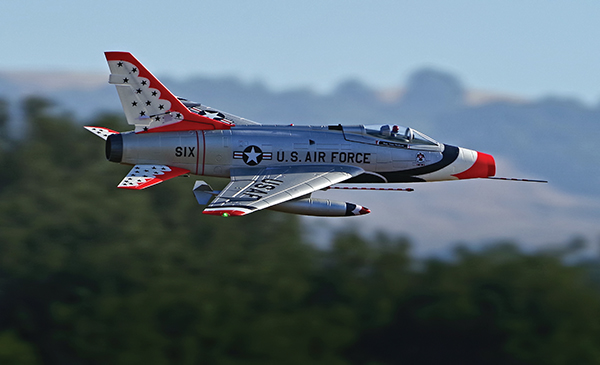
THE BULK OF THE Flex Innovations models thus far have been EPO foam-composition, propeller-powered products. Flex’s initial foray into the world of EPO foam-based jets occurred in 2018 with the release of its 90 mm electric ducted-fan (EDF) sport jet: the 90mm FlexJet (reviewed in the September 2018 issue of Model Aviation).
March 2020 saw Flex Innovations announce the release of its first scale EPO foam-composition, EDF-powered jet: the North American F-100D Super Sabre. March 2020 also saw the worldwide outbreak of COVID-19. This unexpected event quickly caused wide-ranging collateral damage to the world’s economies, including significant production and shipping delays.
EDF enthusiasts, anxious for the arrival of this seldom-modeled aircraft, would have had to wait until late September 2020 for Florida-based Flex Innovations to receive its initial production run of the eagerly anticipated F-100D.
The full-scale F-100 was a supersonic, sweptwing jet that saw service in both fighter and bomber roles. This aircraft was the first of six similarly designed jets that made it beyond the prototype stage and into production.
These six aircraft would later be referred to as the "Century Series." According to Wikipedia, the F-100s "were the longest serving U.S. jet fighter-bomber to fight in the Vietnam War." In recognition of this, Flex offers the Super Sabre in a Southeast Asia camouflage scheme. A sheet of graphics allows pilots who choose this scheme to represent one of four historical squadrons.
The F-100 also gained the unique distinction of being the aircraft used to make up the world’s first supersonic demonstration team! In 1956, the United States Air Force Thunderbirds demonstration team switched from the F-84F Thunderstreak to the F-100C. The team used Super Sabres until 1964, at which time they switched to the heavier Republic F-105 ThunderChief.
A serious accident, after only six performances with the F-105, caused the team to revert to the F-100, specifically the D variant. Flex pays homage to the version of the USAF Thunderbirds aircraft that was used from 1964 to 1969, with its silver color scheme.
Although most of the Thunderbird graphics, including the large, iconic, dark blue bird that dominates the underside of the fuselage, are factory applied, builders do have the responsibility of selecting the pilot and formation position that they want their Super Sabre to represent. The pilots’ roster that was used by Flex appears to cover the 1966-67 team (see the link to a 20-page USAF Thunderbirds brochure in the "Sources" listing).
An initial walk-around and perusal of the kit components right out of the box had me admiring the following notable features: digital 15-gram metal gear servos used on all flight control surfaces and ball links are used on both ends of all of the control surface pushrods. Scale inlet ducting is unmarred by any use of auxiliary inlet ducts (aka cheater holes) and the exhaust ducting utilizes an exhaust tube, sturdy, removable pitot tube, and refueling probe. The model uses accurately scaled, full-flying stabilizers.
Flex even recreated the subtle discoloration of the aft part of the fuselage that is typically evident on full-scale F-100s with unpainted, polished aluminum finishes!
I also noted a couple of features that this model lacks (perhaps to keep the cost of the kit and complexities manageable and within established project design goals), including the absence of gear doors on the main gear, the use of an ESC-integrated internal BEC instead of a typically more robust external BEC, and the manner in which the ESC is placed in the fuselage.
Assembly
Although the current generation of EPO foam-composition models comes out of the box requiring little more than an hour or two of assembly time, EDF pilots who like to preserve their potentially pricey jet models always spend time inspecting the airframe and electronics.
One observation that I made when inspecting the F-100 is that the 100-amp ESC used in this model is located in a flat, narrow tunnel that runs along the fuselage’s dorsal, from the rear of the battery compartment to slightly forward of the EDF unit. I was surprised to find that the 100-amp ESC is not anchored in this location and simply "floats" in place near the middle of this tunnel.
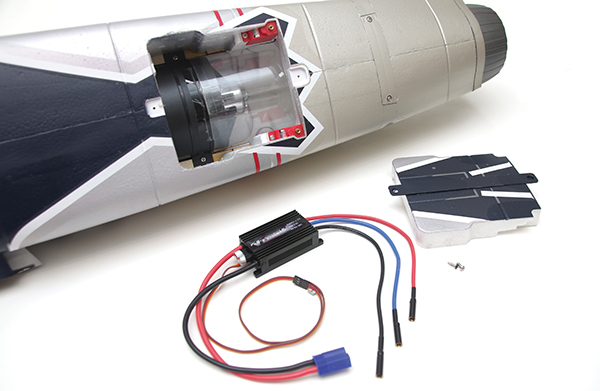
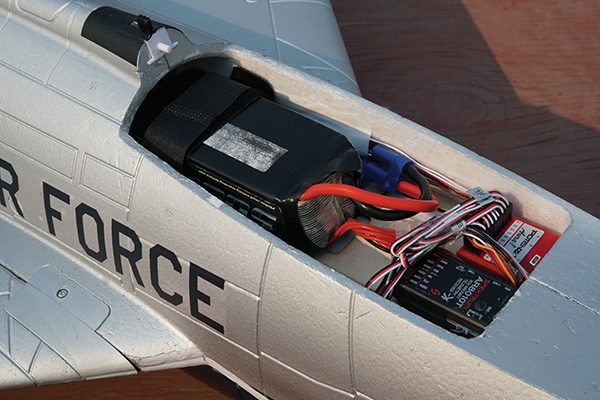
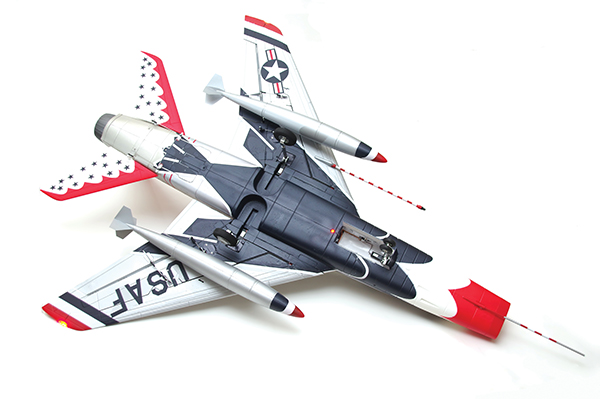
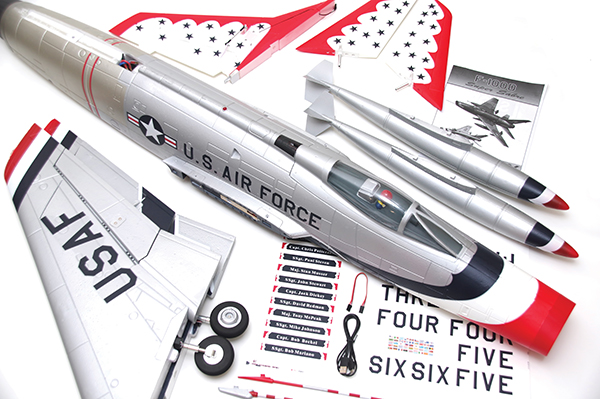










Add new comment